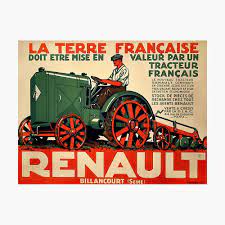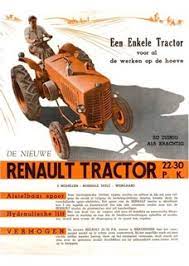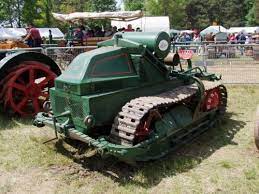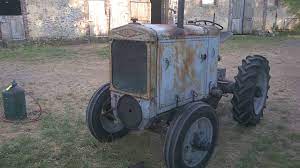Renault
Societe Anonyme des Usines Renault,
Billancourt (Seine), France
History
 Advertisement for
the Renault GP (click on image to enlarge)
Advertisement for
the Renault GP (click on image to enlarge)
The Renault company was founded in 1898 by Louis
Renault and his brothers, Marcel and Fernand, to build automobiles.
Renault's first car was the Voiturette, a name which was applied to
several different models over the next five years. The range soon
expanded to include buses, taxis and commercial vehicles, and with
the onset of the First World War, Renault's production facilities
were turned over to the manufacture of ammunition, aeroplanes and
most significantly, tanks. The Renault FT-17 light tank was the
first to feature a gun in a fully-rotating turret and established
the layout of the driver at the front and engine in the rear. At
least three thousand of these tanks were built by Renault, and the
experience gained in mass-production of tracked vehicles led them to
consider production of an agricultural crawler as early as 1917.
It is often stated that Renault's first
agricultural tractor, the Model GP crawler, was based on the design
of their FT-17 tank, but this is not true. In fact, the basis for
the GP seems to have been the American Cletrac Model R, and photos
exist of a Cletrac in the Renault works that was evidently purchased
for study purposes. The tracks on the early Renault GPs are almost
identical to those on the Cletrac, but totally different to those on
the FT-17 tank, and the GP had the engine at the front rather than
at the rear! Mass production of the GP began in February 1919 on the
same assembly lines used for building tanks, and continued for the
next two years, with a total of 425 units built. The elegant curved
bonnet of the GP reflected Renault's automobile heritage, while the
sloping radiator positioned in the middle of the tractor was
decidedly unconventional, but was essential for the novel method of
cooling using a fan directly behind the engine.
The next distinct model of tractor to emerge was
the HI in 1920. This crawler superficially resembled its
predecessor, but featured numerous improvements to the track system,
transmission and steering, as well as being offered in a
gas-producer version. Production numbers were not that much higher
than for the GP, but HI crawlers were exported to such diverse
places as Russia, Australia and New Zealand. Following trials by the
military authorities in December 1921, the HI was also approved for
inclusion in a scheme whereby owners of these tractors received an
incentive to allow their machines to be requisitioned for military
purposes if necessary. As a result, the army had a guaranteed supply
of tractors at their disposal, but did not need to purchase or store
these tractors themselves. The first Renault wheeled tractor also
appeared in 1920 - this was the HO, which was available both as an
agricultural version on steel wheels and a road version on solid
rubber tyres. Sales were very limited though, mainly because the
tractor was too heavy, too expensive and used too much fuel, and
Renault was forced to address these concerns when designing its next
wheeled tractor, the Model PE.
 Poster advertising
the Renault PE (click on image to enlarge)
Poster advertising
the Renault PE (click on image to enlarge)
The legendary Renault PE was
introduced in 1926
and represented the lighter, more efficient tractor that
medium-sized French farms needed - Renault now had a tractor that
could compete on equal terms with the American Fordson and IHC
10-20. More than 1800 were built before production ended on the eve
of the Second World War, and a crawler version, the PO, was also
offered. The PE initially used the same layout as its predecessor,
with the radiator mounted behind the engine in the middle of the
tractor and a large fan used to draw air into the fully-enclosed
engine compartment; in front of the engine sat a huge air-cleaner to
filter the air entering the carburettor. For the later PE1 and PE2
(as well as the PO crawler), however, Renault switched to a more
conventional design, with the radiator in its more usual position at
the front of the tractor, and this would be the pattern for all
subsequent Renault tractors. The PE also formed the basis for the
Model RK, which was almost identical in external appearance but used
a two-cylinder semi-diesel engine in place of the PE's petrol power
unit and was far less successful.
The 1930s saw Renault expand its range
significantly with the introduction of the little 8hp Model YL
(later AFD), the VY and AFXD diesel models and the AFMD/AFMH crawler
with either a diesel engine or gas-producer unit; industrial
versions of the wheeled models with pneumatic tyres were also
offered. In the post-war period the company went on to develop the
famous R3042 and its derivatives, with a choice of petrol or diesel
engines, and the elegantly styled D-series. Renault established a
reputation for quality that continues to this day, although since
the purchase of Renault Agriculture by Claas in 2004, the familiar
orange livery has been replaced by green and the tractors no longer
carry the Renault name.
Model Details
GP / GU
(1919-1923)
The GP crawler used Renault's
own design of four-cylinder petrol engine, a 95 x 160 mm (4.5 litre)
side-valve that produced 20-30 hp at 1000 rpm. This was cooled by
the thermosyphon method and lubricated by a gear-driven oil pump.
Four forward speeds were provided and power was transmitted to the
gearbox via a cone clutch, and then to the track sprockets via
double reduction gears. The tracks were supported at the front by a
strong leaf spring and the crawler was steered via band brakes on
each track controlled by a T-bar. Early versions of the GP seem to
have been fitted with 17.5 cm wide tracks, based heavily on the
Cletrac R, while later tractors used 27.5 cm tracks (giving an
overall width of around 1.7 m and length of 3.45 m). A limited
number of crawlers were assigned the model designation "GU" - it is
unclear exactly how these differed from the GP, but they may have
had the wider tracks as standard. A total of 502 GP/GU crawlers were
produced, and it is thought that just 33 of these were the GU
version.
HI
(1920-1928)
 Renault HI crawlers
at Camp Coëtquidan, Brittany, France
Renault HI crawlers
at Camp Coëtquidan, Brittany, France
(click on image to
enlarge)
The HI was very similar in appearance to the GP,
but featured a U-frame chassis in place of the GP's channel-iron
design. Early versions used basically the same engine as the GP, but
this received various modifications during the production period so
that the final version had a removable cylinder head and yielded 34
hp at 1200 rpm. The track system was strengthened with heavier track
frames and an arching support for the upper track rollers that
passed over the middle of the tractor; the steering was also
improved by using metal multi-disc clutches to stop the tracks
rather than the inefficient band brakes. Later versions of the HI
featured a larger radiator with a water-bath air-cleaner mounted on
top. A total of 610 HI crawlers were built and a number of these
were fitted with a gas-producer unit mounted at the rear of the
tractor.
HO
(1921-1928)
The Renault HO had the same general layout as its
tracked counterparts, but was shorter, narrower and used a smaller
engine. Initially this was a 95 x 120 mm headless side-valve unit
producing 20 hp at 1100 rpm, but in April 1926 it was replaced with
an 85 x 140 mm unit with removable cylinder head that yielded just
15 hp at 1700 rpm. Tractors with the earlier engine had a
girder-type chassis, but this was replaced with a lighter design
that allowed better access to the engine after the new power unit
was fitted. A three-speed gearbox was used, as on the HI, giving
speeds of between 3 and 10 km/h. Both agricultural and road versions
were offered: the agricultural tractor had riveted sheet-steel
spoked wheels at the rear and cast spoked ones at the front, while
the road tractor had solid rubber tyres on disc-type wheels. Just
210 examples of the HO were built.
PE
(1926-1939)
The PE was a 10-20 hp tractor that weighed just
1300 kg and used a similar engine to several of the company's highly
successful cars. This was the 259-KZ, a four-cylinder 75 x 120 mm
(2.1 litre) petrol unit with removable cylinder head that greatly
reduced the fuel consumption compared with the HO. The radiator was
now in a vertical position, but still initially located in the
middle of the tractor. This all changed, however, with the
introduction of the PE1 in 1931, when the radiator moved to the
front of the tractor, and the same design was used for the PE2,
which appeared in 1935. From 1928 a vineyard version of the PE was
offered, which was narrower with smaller wheels all round and cast
ones the front. Other variants included road versions on both solid
and pneumatic tyres, as well as petrol/paraffin and gas-producer
versions. Optional extras included a belt pulley, mudguards, towing
hook, hydraulic lift and electric lights. A total of 1840 Renault PE
tractors were produced in the different versions.
PO
(1927-1938)
 Renault
RK with
semi-diesel engine (click on image to enlarge)
Renault
RK with
semi-diesel engine (click on image to enlarge)
The PO crawler used a similar engine to the PE,
the side-valve Type 279, which had a bore and stroke of 100 mm and
160mm, respectively, and produced 40 hp at 1300 rpm. The PO was
designed for heavy-duty work including forestry applications and was
huge machine, weighing 4400 kg. It was the natural successor to the
HI, but differed from it in quite a few respects. The radiator was
now located at the front of the tractor and the two vertical springs
for the tracks were now positioned directly below the engine rather
than at the front of the chassis. The upper track roller was set
further back towards the rear sprocket and the arching support was
dispensed with; two separate hand levers were now used to control
the track clutches. In all, 255 Renault PO tractors were produced.
RK
(1930-1938)
The Renault RK used the same chassis and
transmission as the PE, but used a two-cylinder semi-diesel engine
that could burn cheaper, lower-grade fuels than the PE's petrol
power unit. This engine was known as the Type 293 and was of a
'square' design with 130 x 130 mm bore and stroke, producing 20 hp
at 1000 rpm. Before starting, the cylinder heads were heated with
burners until they were hot enough for the fuel to combust
spontaneously under compression; the engine could then be started
and the fuel was injected into the cylinders at the correct time by
an automatic pump. The RK underwent the same changes as the PE with
regard to the position of the radiator, and was also available as a
road version with the optional extras. Despite its ability to burn
cheap fuel, the RK was heavier than the PE, offered no more power,
and cost about 25% more - these factors combined probably explain
why only 113 examples were built.

 Advertisement for
the Renault GP (click on image to enlarge)
Advertisement for
the Renault GP (click on image to enlarge) Poster advertising
the Renault PE (click on image to enlarge)
Poster advertising
the Renault PE (click on image to enlarge) Renault HI crawlers
at Camp Coëtquidan, Brittany, France
Renault HI crawlers
at Camp Coëtquidan, Brittany, France Renault
RK with
semi-diesel engine (click on image to enlarge)
Renault
RK with
semi-diesel engine (click on image to enlarge)